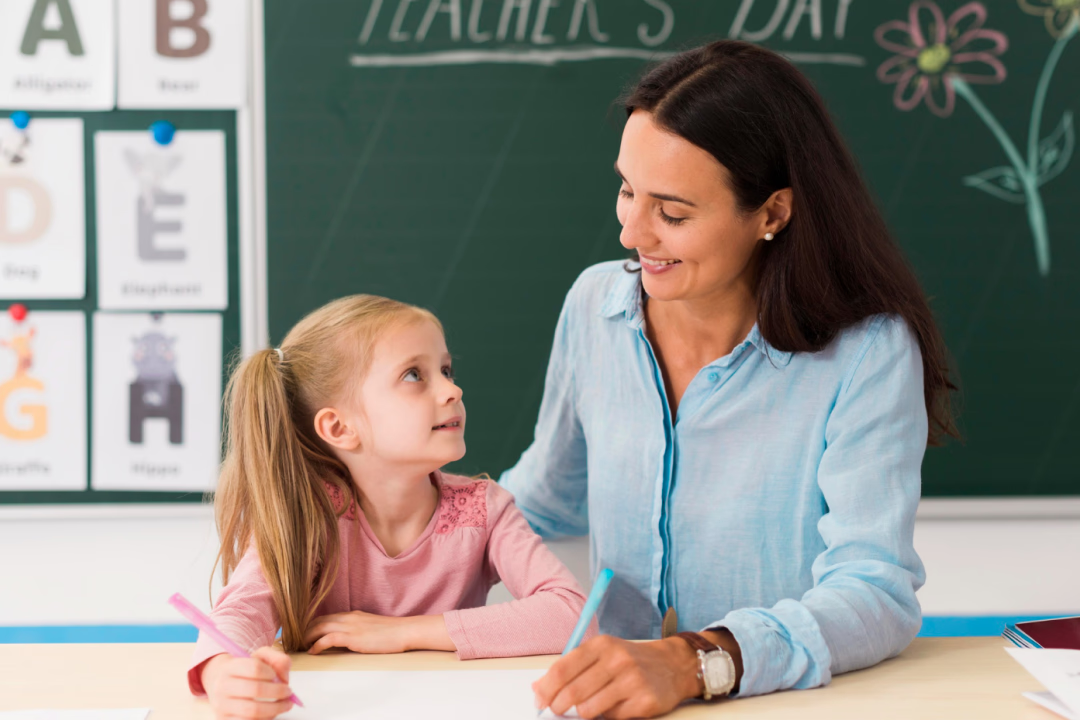Teaching isn’t just a calling; it’s a career built on purpose, passion, and growth.
Yet, in the middle of lesson planning, classroom chaos, and everyday demands, one question often lingers in your mind: “Am I being a good teacher?”
If you’ve ever asked yourself this, you’re not alone. Every dedicated teacher has had this thought. And more often than not, trying to answer it leads to an even bigger question: “What are the characteristics of a good teacher?”
The answer is not about being perfect. Great teaching is built on simple yet powerful habits. Patience, empathy, adaptability, and the ability to connect with students are some of the key qualities of a good teacher. These qualities are not fixed. With awareness and effort, every teacher can develop them further and make an even bigger impact.
Now that you’ve taken a moment to reflect, let’s explore the top 10 qualities of a good teacher that can truly transform your teaching journey.
One of the key characteristics of a good teacher in the 21st century is being intentional. Great teachers do not rely on guesswork or habit. They plan each part of their lesson with a clear purpose. This kind of thoughtful teaching helps students stay focused, feel supported, and understand why they are learning what they are learning.
How to implement it in your classroom:
- Start with clear learning goals. Let your students know what they will learn today and why it matters.
- Use consistent routines. Establish simple, repeatable processes for asking questions, transitioning between tasks, or submitting assignments.
- Plan your questions. Think ahead about what you will ask to challenge your students and encourage deeper thinking.
- Think about timing. Build in short, planned transitions to keep lessons flowing without confusion or wasted time.
These steps reflect some of the best teacher qualities, like clarity, structure, and purpose. Your students will feel more confident and engaged when your teaching feels intentional.
When we ask what are the characteristics of a good teacher, one powerful trait often goes unnoticed, the ability to read the room. Great teachers have a strong sense of awareness. They notice when the energy in the class dips, students are confused, or someone is struggling quietly. This awareness helps them respond in real time, adjusting their pace, tone, or even the activity to support learning better.
How to implement it in your classroom:
- Observe, don’t assume. Pay close attention to facial expressions, body language, and participation. These small cues reveal a lot about how students are feeling.
- Check in regularly. Pause during lessons to ask how students are doing or if something needs to be explained differently.
- Be flexible. If something clearly isn’t working, give yourself permission to shift gears.
- Create space for honesty. Build a class culture where students feel safe telling you when they are lost or overwhelmed.
This kind of responsiveness is one of the most impactful characteristics and qualities of a good teacher. It shows students that you are present, attentive, and willing to meet them where they are.
One of the most valuable characteristics of a good teacher in the 21st century is the ability to make learning feel meaningful and connected to real life. Today’s students are constantly surrounded by information. If they do not see why something matters, they disengage. Great teachers bridge the gap between the curriculum and the world students live in. They make learning relatable, current, and applicable.
How to implement it in your classroom:
- Use real-world examples. Connect lessons to current events, everyday scenarios, or student interests.
- Give learning a purpose. Before starting a topic, explain how it applies beyond the classroom.
- Encourage student voice. Let students bring in their experiences and opinions. This makes the content more personal.
- Use project-based learning. Design activities where students apply what they learn to solve real problems or create something useful.
Making lessons relevant is one of the best teacher qualities because it boosts motivation and helps students retain what they learn. When students understand the “why,” they care more about the “what.”
One of the most impactful qualities of a good teacher is knowing how to set high expectations while offering the support students need to meet them. Good teachers believe in their students’ potential, even when students don’t believe in themselves. They challenge students to aim higher, but always pair that challenge with encouragement, guidance, and patience.
How to implement it in your classroom:
- Be clear about your standards. Let students know what excellence looks like and why it matters.
- Break goals into steps. Help students tackle big tasks by guiding them through smaller, achievable parts.
- Celebrate progress, not just results. Recognize effort, improvement, and persistence to build student confidence.
- Offer constructive feedback. Instead of just pointing out what's wrong, focus on what can be improved and how.
Striking this balance is one of the most powerful characteristics and qualities of a good teacher. It helps students grow without feeling overwhelmed and creates a classroom culture where effort and learning are valued just as much as outcomes.
One of the most essential characteristics of a good teacher in the 21st century is the ability to create a safe, inclusive, and welcoming environment. In today’s diverse classrooms, students come from different backgrounds, experiences, and emotional spaces. A good teacher makes sure every student feels seen, heard, and respected. When students feel safe, they are more likely to take risks, ask questions, and engage in learning.
How to implement it in your classroom:
- Set clear values early on. Establish ground rules that promote kindness, respect, and open communication.
- Model vulnerability. Show students that it’s okay to make mistakes or not know something. This encourages them to do the same.
- Celebrate diversity. Use examples, stories, and materials that reflect different cultures, identities, and perspectives.
- Respond with empathy. When students are upset or struggling, listen without judgment and offer support.
Creating a safe space is one of the best teacher qualities because it builds trust. Students who feel emotionally safe are far more likely to succeed academically and socially.
If you’ve ever wondered what are the characteristics of a good teacher, one answer is their ability to explain things in a way that is both clear and meaningful. Good teachers do not just cover content; they help students truly understand it. They break down complex ideas without oversimplifying and invite students to explore deeper layers of meaning.
How to implement it in your classroom:
- Use simple language for complex ideas. Begin with the basics, then build up gradually.
- Use examples that make sense. Link new concepts to familiar topics or real-life situations.
- Check for understanding often. Ask students to explain the idea in their own words or teach it back to you.
- Encourage deeper thinking. Ask “why” and “how” questions that push students to reflect, connect, and apply.
This balance between clarity and depth reflects some of the most important characteristics and qualities of a good teacher. It shows that you value not just what students learn, but how deeply they understand it.
Classrooms are unpredictable. Lessons that seemed perfect on paper might fall flat, a tech tool might stop working, or a student might need more support than expected. One of the most practical qualities of a good teacher is flexibility — the ability to adapt without losing momentum or patience. Good teachers calmly adjust their approach based on the moment.
How to implement it in your classroom:
- Have a backup plan. If an activity doesn’t go as planned, be ready with an alternative.
- Adapt to your students’ pace. If a class needs more time on a topic, slow down. If they already know something, move forward.
- Create flexible routines. Build structure, but leave room for minor changes when needed.
- Stay calm during disruptions. Model problem-solving instead of reacting emotionally.
Being flexible helps you stay in control while meeting students where they are. One of the many qualities of a good teacher is the ability to turn challenges into learning opportunities for you and your students.
One of the defining characteristics of a good teacher in the 21st century is the mindset of lifelong learning. Great teachers do not stop growing once they enter the classroom. They stay curious, seek feedback, and stay updated with new teaching methods, tools, and ideas. In a rapidly changing world, students need teachers who evolve with them.
How to implement it in your classroom:
- Reflect regularly. After each lesson or week, take a moment to consider what worked and what could be improved.
- Welcome feedback. Invite input from students, peers, or mentors. Use it to fine-tune your teaching.
- Stay updated. Follow education blogs, attend webinars, or join professional learning communities.
- Try something new. Experiment with a new tool, teaching strategy, or classroom practice; even small changes matter.
Being open to growth improves your teaching and models a powerful example for your students. It reminds them that learning is a lifelong journey.
One of the best teacher qualities is the ability to build genuine relationships with students. Great teachers don’t just focus on academics. They take time to understand who their students are as people — what excites them, what worries them, and how they learn best. These connections create a sense of belonging that motivates students to show up and try their best.
How to implement it in your classroom:
- Learn names and interests quickly. Use what you learn to make conversations and examples more personal.
- Be available and approachable. Create moments throughout the day where students feel safe to talk.
- Show interest beyond the classroom. Ask about their hobbies, projects, or how they’re feeling.
- Celebrate small wins. Notice and acknowledge effort, improvement, and kindness, not just top scores.
Strong relationships create a foundation for trust, respect, and learning. This emotional connection is one of the best teacher qualities because it supports not just academic success, but long-term growth and confidence in students.
Among the most underrated qualities of a good teacher is the humility to admit when you do not know something. Teachers are often expected to have every answer, but the truth is that learning never stops, even for educators. A good teacher sees curiosity and uncertainty as opportunities to grow alongside their students, not as weaknesses.
How to implement it in your classroom:
- Model curiosity. When a student asks something you are unsure about, say, “Let’s find out together.”
- Use questions to explore. Encourage students to research and present answers, making it a shared learning experience.
- Celebrate learning moments. Let your class see you get excited about discovering something new.
- Create a culture of inquiry. Make it normal for everyone, including you, to ask questions without fear.
This approach builds trust and encourages students to embrace learning as a lifelong process. Among all the qualities of a good teacher, the willingness to learn with your students is one of the most powerful ways to lead by example.
You’ve just explored some of the most impactful qualities of a good teacher, traits that go beyond technique and shape how students experience learning. As you reflect on your own teaching journey, take a moment to think about which of these characteristics come naturally to you, and which ones you would like to strengthen.
If you’re looking for structured support to develop these skills further, Suraasa’s Professional Graduate Certificate in Teaching and Learning (PgCTL) offers a practical, in-depth path. The program is designed for teachers who want to build real classroom impact through intentional, 21st-century teaching practices.
Becoming a better teacher is a journey. The most important step is choosing to grow.











.avif)




